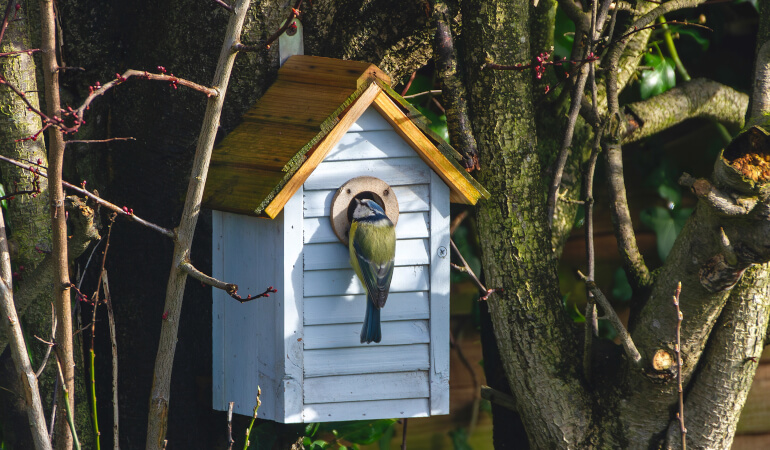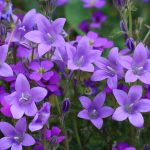Birds make a great addition to your garden, they’re great to look at and they’re useful as well. For instance, they will eat slugs, snails, aphids, insects and other well-known troublemakers.
It’s not that difficult to create a bird-friendly garden that attracts wildlife. All you have to do is provide the main things that the feathered fellows need: food, water, shelter and safety.
Table of Contents
Provide food sources
Nothing attracts animals, as well as food, does. Feeding birds year-round will make them stay with you. A mixture of seeds including millet, sunflower and hemp will attract many of the more colourful specimens, like tits and even bullfinches. Most gardeners worry about attracting pigeons as well, so to avoid that exclude wheat from the planned menu.
Fat balls are especially useful in the winter months as the high energy content will help your feathered friends resist the cold. There are also mealworms which come in dry or live form and are quite popular among robins and starlings.
Bird feeders come in different models, too. You can find tube feeders which you can hang on a tree branch, freestanding feeders, platform feeders and so on. Find these in any garden centre, most DIY stores, or why not even make your own.
You can easily make your own bird feeder with recycled materials. Here is a quick guide.
How to make a bird feeder
- Find an unused container. A plastic cup might do just fine, but if you want your feeder to last, you might need something more durable. Empty metal paint can do the trick just fine.
- Attach an unused stick. Birds will find it hard to land on the box and eat. If they’re hungry, they’ll find a way anyhow, but to make them comfortable, you can attach a wooden stick to the opening of the paint box. You can use packing tape to mount it securely in place.
- Decorate. With the packing tape still on, your feeder wouldn’t be the most pleasant thing to look at. The birds won’t mind, but if you want to make it prettier, you can arm yourself with paint and brushes, and decorate your feeder just the way you like.
- Hang on a branch. You can improvise with just about anything – from standard rope to ribbons and even metal hinges for the most security.
- Fill up. Pour some bird food inside and you’ll have some friendly visitors the same day.
Having more than one bird feeder will give you the chance to try placing different types of food to attract various bird species. So feel free to experiment with food, feeding spots and feeding devices.
Where to put bird feeders in the garden?
Birds need to feel safe to come and eat from your feeders, so make sure you place the devices in a sheltered and quiet location, preferably away from fences, high bushes or other dense vegetation. The latter can easily provide hiding spots for predators such as cats.
Also, make sure to regularly check, clean and refill the bird feeders so your new friends continue to visit for a meal.
Add water feature
Along with plenty of food, birds also need water for drinking and bathing, so it’s only natural that you should provide them with that, too.
Unfrozen drinking water is vital in winter, but many birds also enjoy bathing and a simple bird bath will only set you back a few pounds. If you have a spare tray or bowl, these could work just fine, as well. Bathing birds are great fun to watch!
What colour bird bath attracts birds the most?
Birds are visually stimulated creatures, with a sharp eye for colours. So aim for bird baths in green or brown that would blend easily with the natural environment, giving birds the confidence to splash around without fear of predators.
Blue, on the other hand, mimics the appearance of inviting bodies of water from above, so it can be a good choice as well.
Guarantee shelter and safe nesting sites
Many species like to pop over to the bird feeder for a quick snack, then retreat into the safe cover of nearby trees or shrubs. Many plants that provide shelter will also double up as a food source in berries which also add autumn colour to your garden.
Birds use the winter to check out nesting sites and will be suspicious of new boxes initially. But, once they deem your birdhouse safe enough, they will take advantage of it quickly. You can buy them at your local gardening store, or make them yourself.
How to build a birdhouse
- Get materials. The best material for birdhouses is wood. Find a few durable boards and arm yourself with tools. You’ll need a tape measure, framing square, saw, paintbrush, clamps, and a drill.
- Cut the wood. Cut the wooden boards with the saw in the shapes needed for the walls, floor and ceiling of your birdhouse. You can improvise with designs, or you can simply cut it into six squares. Your choice.
- Drill a hole in the middle of one of the boards. You need to make it big enough for a bird to get in – that will be your entrance.
- Assemble the box. Use glue to attach the walls, bottom and top together. Once it’s stable enough, use a hammer and nails to keep it all together.
- Decorate. Apply water-based exterior paint in the colour you like.
- Hang your construction. Once the paint is dry, use a wire, chain or rope to hang it securely on a tree branch.
- Clean the birdhouse. If you notice the birdhouse is unoccupied, it would be a good idea to take it down and clean it with boiling water for the next bird that chooses it for shelter. Be sure to use gloves and a face mask.
How to encourage birds to nest in your garden?
In addition to hanging one or more birdhouses outside, you can also attract birds by providing them with materials they normally use to build nests. So it doesn’t necessarily have to be your birdhouse they come for into your garden. It can always be a tree they chose for a nest.
You can scatter things around like wool, pet hair and straw. Another good idea is to stuff these materials into crooks of trees, and if you can find an unobtrusive space where you can have a muddy patch in dry conditions, the birds will love you even more.
Introduce plants attractive to birds
The key is to cultivate a variety of plants that provide a feast and serve as shelter for the feathery companions, as well as enrich your garden’s appearance.
The berries of rowan trees, hawthorn bushes and holly, for example, can offer necessary sustenance during the winter months. Sunflower seeds can also be a great food source for a variety of birds. Plant ivy and honeysuckle around fences or trellises to attract hummingbirds and butterflies.
Minimise the repellents
Without realising it, you may have made your garden to be repelling for bird visitors. And, no matter how many bird feeders and water features you include, they may still be scared to come near. To be sure your yard is an inviting and safe space for the little feathered fellows, you can make some changes.
- Listen for unpleasant sounds. Birds have evolved to be able to hear sneaking predators, which is why their sense of hearing is very sharp. If there is a loud noise coming out of your house and garden, they might not come.
- Do not use chemicals. Using any chemicals on your plants would not just repel the insects, but the birds as well. Sometimes the smell alone is enough.
- Remove tree decorations. Anything in bright colours and with a strange-looking shape will tell birds to keep away. Just like a scarecrow is able to scare them away, these might too.
What garden birds can you attract in UK?
There are many species of birds in the UK and most of them can be easily attracted to your garden, as long as your house isn’t situated too close to a big city. Big cities are usually only penetrated by predatory birds, like owls and gulls (in cities near the shore).
Some often-seen species are:
- Coot;
- Woodpecker;
- Jay;
- Peregrine;
- Robin;
- Skylark.
And many others. See a full list of British Garden Birds.





You should probably add some information about seed mixes -not directly for food but they grow into plants that birds like for feed, nesting materials and cover. They are cheap to buy and use. If you have an untidy garden patch or a verge that you aren’t using for anything else then think about throwing some suitable seed down.
I have never actually cleaned out a birdhouse before! I can see how a dirty one would deter other birds from moving in. When we do get one, I will make sure to clean every time a little bird family moves out. Thanks!